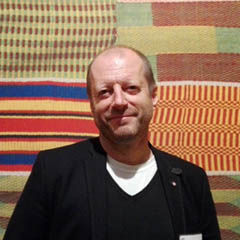Godfried Donkor is now considered one of the most renowned British artists with numerous acclaimed solo and group exhibitions in Africa, Europe, North and Latin America, including "Around the world in 80 Days" at the ICA (London), "Pin Up" at the Tate Modern (London) and "Authentic/ Excentric" at the Venice Biennale 2001. His multimedia visual art practice incorporates collage, printmaking, photography, film and performance. He is joint founder of "AISS-Art in Social Structures" and has participated in a number of residency programs in Africa, Europe, the US, and the Caribbean. In his works, Donkor creates visual references to the buried and repressed relationships between "black and white", between the upper and lower classes.
Based on profound research, he tells multifaceted counter-histories that reveal the hidden principles of production and exchange in historical and modern societies. At the core of his work are questions about the stereotyping of black people and their reduction to their physicality - firstly in slavery, then in sport, in the fashion- as as well as in the sex industry. In his work "From Slave Ship to Champ" (1992), for example, the slave ship, contrasted with images of black boxers in classic prizefighter poses, becomes a kind of "womb" and „uterus“ of particular types of racism. In Donkor's work, the historical slave trade also becomes a metaphor for current degrading mechanisms of the globalised world and leads to the question: How far is it from slave ship to champion - is it very far, or not far enough?
He questions the supposed "neutrality" of stock market prices and statistics in his series "Financial Times", in which he uses the serious-looking stock market pages of this newspaper as a background and alienates them collage-like with black and white images or full-colour glossy magazine figures of boxers and African women.
"The black body“ as a commodity in Western culture is also the focus of his "Southern Vogue" series. He traces the ways in which women's bodies, in particular, were and are degraded into marketable commodities and how people were and are degraded into financial objects. Donkor's work has much to do with the fragile and ever-threatened dignity of human beings. He asks questions about victimisation and innocence, about the balances and imbalances of the world, but does not allow for one-dimensional quick answers. Rather, he creates not only alternative histories, but also alternative icons. In his "Browning Madonna", "Black Madonna" (2002/6) and "Birth of Venus" series, for example, he takes up Western pictorial motifs, "africanises" them and thus creates a field of tension between the elevation and exploitation of - not only black - women and men.
Donkor's conceptually multilayered works are often inspired by places that played an important role in the historical slave trade. The artist uses the architecture of these places and the goods that were and are produced there to refer to the social conditions and interactions that lie behind them. This is exemplified by "Once upon a time in the West there was lace" (2007), with which Donkor reflects parallels between modern day and historical slavery through cotton and lace in Nottingham (UK). The luxury good lace, that is still synomymous with this English city, stands for the lavish lifestyle of the elites of the 18th and 19th centuries and at the same time for the exploited manufacturers who were often forced to live in great poverty. Donkor links this status symbol with his horrific history, and at the same time refers to the exploitative mechanisms of the current economic world.
The location also plays a leading role in the performance/fashion/video installation "Jamestown Masquerade" (2004). The Ghanaian coastal town of Jamestown is one of the first communities to make contact with Europeans in the 18th century. In Donkor's work, this place now becomes an archetypal city for commerce exchange and a symbol of the cultural interplay between Europe and West Africa from the 18th century to the present. In this performance, Present day Jamestown becomes the setting for a masquerade of fashion and memory in which African performers wear English costumes from the 18th century and are accompanied by music by Handel and Mozart. In this way, Donkor also points out that the meeting of two cultures does not necessarily have to be destructive, but can also offer a great deal of creative scope for both sides.

